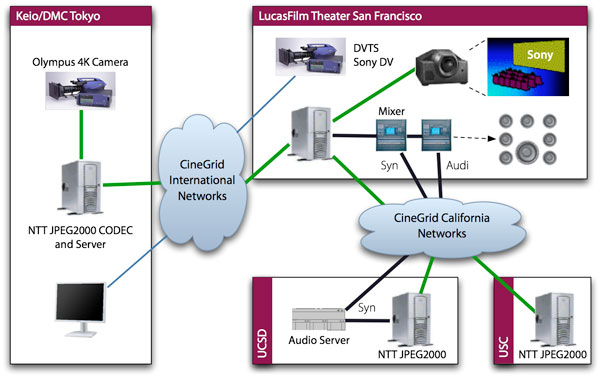
The CineGrid@AES demonstration showed that multi-channel, non-compressed cinema-quality audio streaming over IP works well, sounds good, and is now feasible for real-world applications. Content included a 4K telepresence session used for interactive video-conferencing and ultra-realistic reproduction of a live performance of the Keio Wagner Society String Ensemble transmitted in 4K with multi-channel audio from Keio University in Tokyo.
Chris Sarabosio, a senior sound designer at Skywalker Sound, a Lucasfilm Ltd. Company, said: “With the experimental system used at the CineGrid@AES event, I was able to control playback and mix 24-channel audio interactively while watching the synchronized picture on the big screen just like I do normally, only this time the audio servers were 500 miles away connected by CineGrid. This approach clearly has the potential to eliminate distance as a barrier to collaboration.”
Two months later, on December 14-15 2006, over 100 people attended the First Annual CineGrid International Workshop,12 sponsored by CISCO Systems, Inc. and Pacific Interface, Inc., and hosted at Calit2, UCSD Division. This workshop also marked the successful linking13 of Ryerson University Rogers Communications Centre in Toronto, Canada’s largest media training center, into the CineGrid optical network.
Going forward, the non-profit organization CineGrid.org14 will be organizing many more events and demonstrations involving the creation, distribution or use of high quality digital media content, including the accelerated preservation of cultural heritage assets captured in picture and sound. Members are exploring the feasibility and trade-offs of different networking approaches suitable for emerging applications of rich-media intensive forms of art, entertainment, distance learning, scientific visualization, remote collaboration and international cultural exchange. To support members’ research projects, CineGrid is organizing network test beds between limited numbers of trusted users around the globe. Many CineGrid members plan to meet at GLIF in Prague, in mid-September, and then again at Calit2 UCSD division for the Second Annual CineGrid Workshop in mid-December 2007.
In summary, 4K video streams are a new data object rapidly emerging from multiple disciplines that require a high performance cyberinfrastructure. We have described the early stages of development of the CineGrid project, which has prototyped the needed cyberinfrastructure, building on the last five years of CI research in the NSF-funded OptIPuter project. Over the next year we expect to see a rapid global rise of the use of 4K over dedicated lambdas, adding to lower resolution video streaming that now accounts for over half the traffic on the shared internet.
2 See en.wikipedia.org/wiki/35_mm_film
3 www.mpaa.org/press_releases/boy%20scouts%20press%20release.pdf
4 The Digital Cinema Initiatives (DCI)
[www.dcimovies.com], a joint venture of Disney, Fox, Paramount, Sony Pictures Entertainment, Universal and Warner Bros. Studios, has established voluntary specifications for an open architecture for digital cinema. These are now being refined as open standards by the Society of Motion Picture and Television Engineers (SMPTE).
5 OptIPuter - www.optiputer.net/
The OptIPuter is being developed under a 5-year research program funded by the National Science Foundation, under the leadership of Calit2 at University of California, San Diego (UCSD) and the Electronic Visualization Laboratory (EVL) at University of Illinois at Chicago (UIC).
6 For more information on Calit2, iGrid 2005, and EVL, see: UCSD/Calit2 - www.calit2.net/
iGrid 2005 - www.igrid2005.org/
and, EVL - www.evl.uic.edu/
7 Shimizu, T., Shirai, D., Takahashi, H., Murooka, T., Obana, K., Tonomura, Y., Inoue, T., Yamaguchi, T., Fujii, Ohta, N., Ono, S., Aoyama, T., Herr, L., van Osdol, N., Wang, X., Brown, M., DeFanti, T., Feld, R., Balser, J., Morris, S., Henthorn, T., Dawe, G., Otto, P., Smarr, L. “International Real-Time Streaming of 4K Digital Cinema,” Future Generation Computer Systems, Volume 22, Issue 8, Elsevier, October 2006, pp. 929-939.
8 This first CineGrid experiment was a joint effort of Keio University/DMC, UCSD/Calit2, UIC/Electronic Visualization Laboratory, NTT Network Innovation Laboratories, and Pacific Interface, Inc. Valuable cooperation, equipment loans, and staffing came from SGI, Sony Electronics, Olympus, Toppan, Mitsubishi Electric, Astrodesign and Yamaha. Additional content was provided courtesy of USC School of Cinema TV, UIUC/NCSA, Tokyo University of Technology, and ARRI.
9 At the end of the 3-day demonstration, the equipment was dismantled. In October 2005, however, Calit2 installed a permanent 4K Sony SRX-R110 projector and a SGI Prism with 21TB of ultra-fast disk, 10GigE-connected to the NLR. We are currently developing alternate means to drive the Sony projector using PCs with synchronized NVIDIA cards as 4K drivers.
10 This demonstration, called Soundscape, was organized with additional collaboration from Skywalker Sound, UCSD’s Center for Research in Computing and the Arts, Youth Radio, San Francisco State University’s Institute for Next Generation Internet, and the University of California Office of the President in Oakland (providing the location for the equipment because it is connected to CENIC).
11 The First Mile Soundscape demonstration was staged at San Francisco State University’s Institute for Next Generation Internet.
12 Videos of talks are available at www.calit2.net/newsroom/article.php?id=1011
13 This was an outcome of the University of California’s Canada-California Strategic
Innovation Partnership Summit, enabled by cooperation between CENIC, Pacific Wave, NLR, and CANARIE.
14 See www.cinegrid.org/






